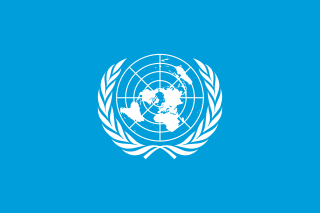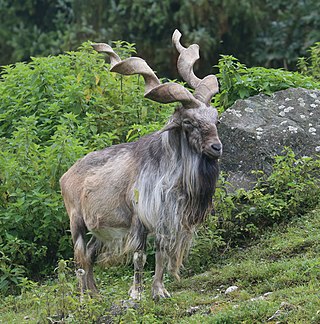Related Research Articles

The International Union for Conservation of Nature (IUCN) is an international organization working in the field of nature conservation and sustainable use of natural resources. Founded in 1948, IUCN has become the global authority on the status of the natural world and the measures needed to safeguard it. It is involved in data gathering and analysis, research, field projects, advocacy, and education. IUCN's mission is to "influence, encourage and assist societies throughout the world to conserve nature and to ensure that any use of natural resources is equitable and ecologically sustainable".

The International Day of Solidarity with the Palestinian People is a UN-organized observance. Events are held at the United Nations headquarters in New York, as well as at the United Nations offices at Geneva, Vienna and Nairobi. It is generally held on November 29 each year to mark the anniversary of resolution 181 which advocated for the partition of Palestine into two States: one Arab and one Jewish. In 2003, it was observed on December 1.

United Nations Day is an annual commemorative day, reflecting the official creation of the United Nations on 24 October 1945. In 1947, the United Nations General Assembly declared 24 October, the anniversary of the Charter of the United Nations, to "be devoted to making known to the people of the world the aims and achievements of the United Nations and to gaining their support for" its work.

Capra is a genus of mammals, the goats, comprising ten species, including the markhor and several species known as ibexes. The domestic goat is a domesticated species derived from the bezoar ibex. It is one of the oldest domesticated species of animal - according to archaeological evidence its earliest domestication occurred in Iran at 10,000 calibrated calendar years ago.

The markhor is a large wild Capra (goat) species native to South Asia and Central Asia, mainly within Pakistan, India, the Karakoram range, parts of Afghanistan, and the Himalayas. It is listed on the IUCN Red List as Near Threatened since 2015.

The International Council for Game and Wildlife Conservation (CIC) (French: Conseil International de la Chasse et de la Conservation du Gibier, German: Internationaler Rat zur Erhaltung des Wildes und der Jagd) is a politically independent not-for-profit international organisation, aiming to preserve wildlife through the promotion of sustainable use of wildlife resources. The initialism "CIC" comes from the organisation's original French name Conseil International de la Chasse.

The wild goat is a wild goat species, inhabiting forests, shrublands and rocky areas ranging from Turkey and the Caucasus in the west to Turkmenistan, Afghanistan and Pakistan in the east. It has been listed as near threatened on the IUCN Red List and is threatened by destruction and degradation of habitat.

International Mother Language Day is a worldwide annual observance held on 21 February to promote awareness of linguistic and cultural diversity and to promote multilingualism. First announced by UNESCO on 17 November 1999, it was formally recognized by the United Nations General Assembly with the adoption of UN resolution 56/262 in 2002.
The United Nations Human Settlements Programme (UN-Habitat) is the United Nations programme for human settlements and sustainable urban development. It was established in 1977 as an outcome of the first United Nations Conference on Human Settlements and Sustainable Urban Development held in Vancouver, Canada, in 1976. UN-Habitat maintains its headquarters at the United Nations Office at Nairobi, Kenya. It is mandated by the United Nations General Assembly to promote socially and environmentally sustainable towns and cities with the goal of providing adequate shelter for all. It is a member of the United Nations Development Group. The mandate of UN-Habitat derives from the Habitat Agenda, adopted by the United Nations Conference on Human Settlements in Istanbul, Turkey, in 1996. The twin goals of the Habitat Agenda are adequate shelter for all and the development of sustainable human settlements in an urbanizing world.

The Marco Polo sheep is a subspecies of argali sheep, named after Marco Polo. Their habitat are the mountainous regions of Central Asia. Marco Polo sheep are distinguishable mostly by their large size and spiraling horns. Their conservation status is "near threatened" and efforts have been made to protect their numbers and keep them from being hunted. It has also been suggested that crossing them with domestic sheep could have agricultural benefits.
The United Nations Division for Palestinian Rights (UNDPR) is a part of the Department of Political Affairs of the United Nations Secretariat.

The year 2011 was declared the International Year of Forests by the United Nations to raise awareness and strengthen the sustainable management, conservation and sustainable development of all types of forests for the benefit of current and future generations.
Afghanistan has long been known for diverse wildlife. Many of the larger mammals in the country are categorized by the International Union for Conservation of Nature as globally threatened. These include the snow leopard, Marco Polo sheep, Siberian musk deer, markhor, urial, and the Asiatic black bear. Other species of interest are the ibex, the gray wolf, and the brown bear, striped hyenas, and numerous bird of prey species. Most of the Marco Polo sheep and ibex are being poached for food, whereas wolves, snow leopards and bears are being killed for damage prevention.

The World Heritage Convention, formally the Convention Concerning the Protection of the World Cultural and Natural Heritage, is an international treaty signed on 23 November 1972, which created the World Heritage Sites, with the primary goals of nature conservation and the preservation and security of cultural properties. The convention, a signed document of international agreement, guides the work of the World Heritage Committee. It was developed over a seven-year period (1965–1972).

The wildlife of Pakistan comprises a diverse flora and fauna in a wide range of habitats from sea level to high elevation areas in the mountains, including 195 mammal, 668 bird species and more than 5000 species of Invertebrates. This diverse composition of the country's fauna is associated with its location in the transitional zone between two major zoogeographical regions, the Palearctic, and the Oriental. The northern regions of Pakistan, which include Khyber Pakhtunkhwa and Gilgit Baltistan include portions of two biodiversity hotspot, Mountains of Central Asia and Himalayas.
The Astor markhor or flare-horned markhor is a subspecies of the markhor, native to Kashmir and northern Pakistan. To the west it reaches the easternmost parts of Afghanistan. The range of the Astor markhor is very scattered. At one time considered an "endangered species", conservation efforts have had some success and the largest subpopulation in Pakistan may now exceed 1000 individuals. As a result, the International Union for Conservation of Nature has rated its status as "near-threatened".

Pakistan's native fauna reflect its varied climatic zones. The northern Pakistan, which includes Khyber Pakhtunkhwa and Gilgit Baltistan, has portions of two biodiversity hotspots, Mountains of Central Asia and Himalayas.

On 20 December 2013, at its 68th session, the United Nations General Assembly (UNGA), in its resolution UN 68/205, decided to proclaim 3 March, the international day of the adoption of the Convention on International Trade in Endangered Species of Wild Fauna and Flora (CITES) on the planet raise awareness and benefits fauna and flora in 1973, as World Wildlife Day. The commemoration was proposed by Thailand to celebrate and raise awareness of the world's wild fauna and flora.
World Cities Day is an annual United Nations observance day held on 31 October. The global observance, first held in 2014, is organized by the United Nations Human Settlements Programme (UN-Habitat) in coordination with each year's selected host city.

The Kashmir markhor, Pir Panjal markhor, or flare-horned markhor is a possible subspecies of Capra falconeri endemic to the Western Himalayas of India and Pakistan. Many, including the IUCN, do not consider it a separate subspecies.
References
- 1 2 "International Day of the Markhor".
- 1 2 "UN declares May 24 as int'l day of Markhor, Pakistan's national animal". 3 May 2024.
- ↑ "Int'l Day of Markhor being observed today".
- ↑ "Pakistan celebrates first 'Int'l Day of Markhor'". 24 May 2024.
- ↑ Nations, United. "International Day of the Markhor". United Nations.
- ↑ Nations, United. "International Day of the Markhor". United Nations.